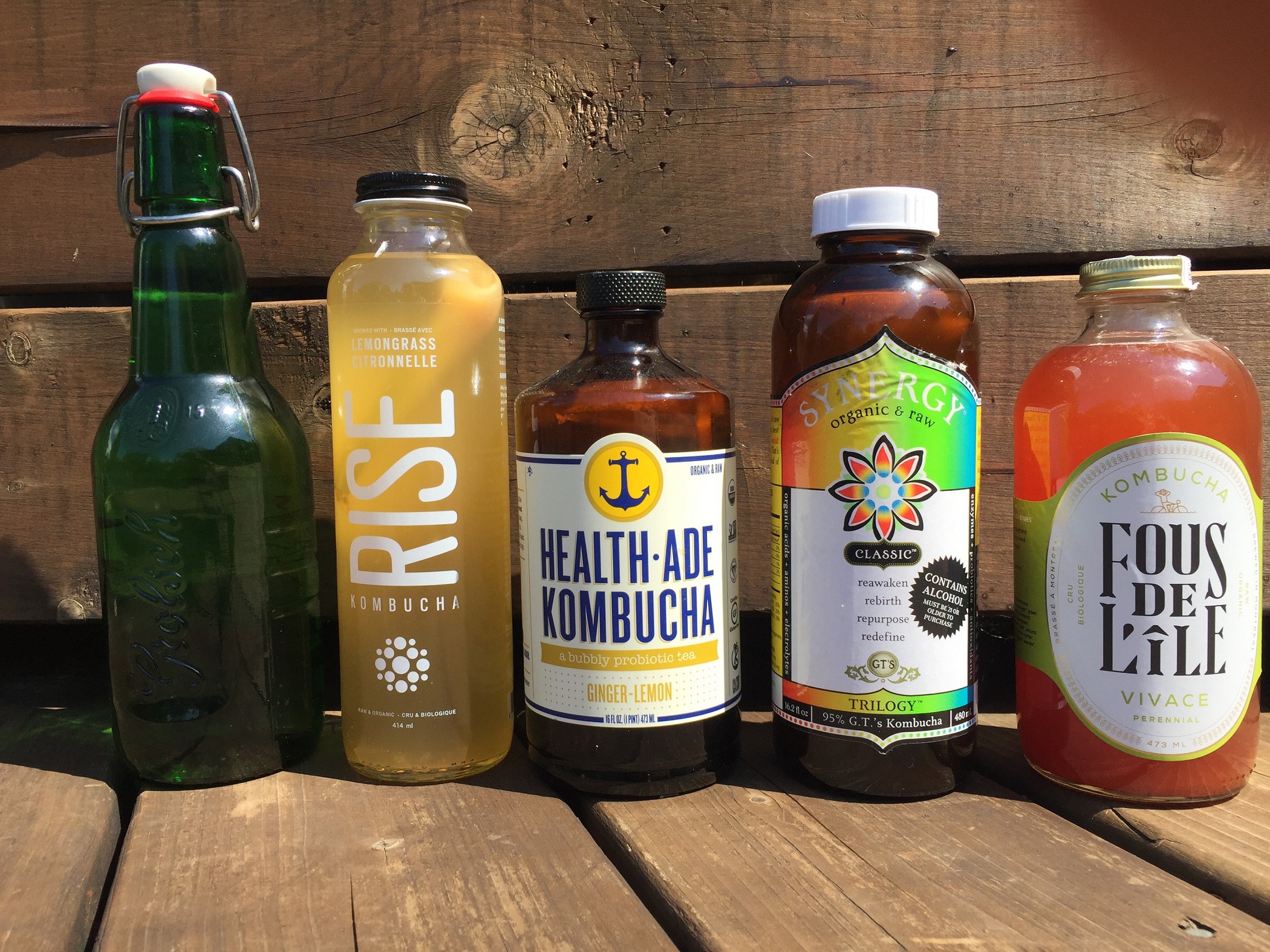Kombucha is very IN right now and can be quite expensive sometimes. Also, I find that some brands are way too sweet to my taste.
did you know that kombucha is super easy to make and will cost you practically nothing?
The final product contains a mixture of bacteria and beneficial yeasts that are beneficial to your gut health (probiotics) as well as certain acids (gluconic, acetic, lactic, glucoronic, citric) and enzymes that will promote better digestion and possibly better health! The blend varies from batch to batch. This is why this elixir can’t be patented? It embodies change.
- Kombucha is an excellent source of probiotics and therefore helps to have a diversified bacterial flora.
- It helps our body detoxify and strengthens the immune system.
- It helps to increase energy and restores the hydration and electrolytes your body needs. This makes it a great drink for the day after a night of partying!
- Kombucha also has an adaptogenic effect on our body. This means that it will help our body to regain its balance. So if someone is suffering from high blood pressure, kombucha will help normalize the pressure. If the person has low pressure, kombucha will help normalize the pressure upwards. In short, it helps the body regain its state of balance (homeostasis). Its also very good to help conteract effect of stress.
- I love to use green tea to make my Kombucha because it has many health benefits. All teas come from the same tree (Camelia Sinensis) and it is the oxidation and fermentation of the leaf that will determine the colour of the tea and its taste. Green tea is the most popular and it retains all these virtues because it is the one that undergoes the least transformation. Make sure to buy organic tea so there is no harsh chemical on the leaves.
Did you know that tea is the second most consumed beverage on the planet after water?
- Green tea contains EGCG, which is a catechin, the main polyphenol in green tea. Thanks to the EGCG in green tea, this beverage is rich in antioxidants, which helps fight free radicals and slow down the premature aging of our cells.
- Green tea promotes the activation of your metabolism and stimulates the elimination of fats in the body. Interesting, isn’t it? A bit of grapefruit essential oil with that?
- EGCG helps control insulin sensitivity, which can be very effective in regulating blood sugar levels and help people who suffer from insulin resistance or type 2 diabetes.
- It may also have a beneficial effect on improving good cholesterol (HDL) and reducing bad cholesterol (LDL) in the blood.
- It is believed to have anti-cancer effects and may help reduce the risk of cardiovascular disease.
- Green tea unfortunately has an effect on the body’s absorption of iron, so avoid drinking it when you eat. It is best to wait an hour before or after eating.
Every batch of kombucha is different and unique…just like you.
Here are some interesting facts:
The oldest reference to Kombucha dates back to 221 BC and is believed to come from China. At that time, Kombucha was known as the “Elixir of Longevity” or the “Divine Tsche” (Tsche means Tea).
Kombucha was imported by Russian sailors to the Baltic countries at the beginning of this decade and then spread rapidly to Eastern Europe. During the Second World War, restrictions on sugar and tea stopped the fermentation of kombucha, but it quickly returned to Germany, Italy, France and Spain as soon as the war ended.
According to legend, it was in 14AD that this beverage received its name. It is said to have been named after a Korean doctor named Kombu who used it to treat the Japanese emperor Inkyo. “Kombu” + “`ch`a” (which means tea in Chinese), hence the name Kombucha!
What is a Scoby?
The word scoby is actually an acronym which means Symbiotic Colony Of Bacteria and Yeast. It means a set of bacteria and yeasts that work symbiotically (together). This symbiosis takes place inside a cellulose “pancake” created by certain bacteria and yeasts.
This scoby will undergo lacto-fermentation on a base of sugar and tea providing it with a source of mineral salts, which it will “feed” on.
The scoby is the “mother” you will need to make kombucha, however, it is always possible to start a new scoby from a kombucha drink alone and a little white vinegar, but it is a little more complicated.
Your Scoby should have a rubbery texture and should not be easy to tear. The ideal thickness is about 4-6 mm or more and it doesn’t really matter how big it is. The scoby takes the shape of the jar in which it is formed. When you are going to produce your kombucha, a new layer will occur on top of the mixture each time. This is the magic of kombucha. You can offer this new specimen to a friend who wants to make his own kombucha or you can keep it for your next batch. The baby scoby and the mother should to be easily separated.
You can reuse your scoby 6-8 times before throwing it into the compost. Now it will be time to use your young scoby and it will be full of vitality.
How to make Kombucha?
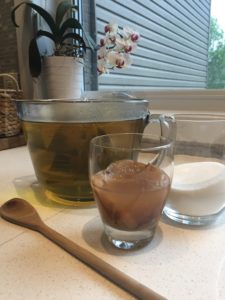
You will need:
- 6 to 8 bags of organic green tea or organic black tea. (about 6 teaspoons if using leaves)
- 4 cups of very hot filtered water.
- 1 Scoby
- 3/4 cup of raw sugar (apparently, its better to use white sugar for this, but I don’t)
- 1 to 2 cups kombucha from your last batch or 1 tbsp cider or white vinegar
- A glass jar for fermenting the kombucha
- cheesecloth
- a rubber band
- a wooden spoon
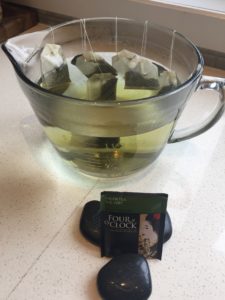
Start by preparing an infusion of green or black tea.
Use filtered water to avoid any chemicals in the tap water. If you wish to use tap water, boil it for 5 minutes before use. Wait until the water is hot but not boiling before adding tea. The ideal temperature for brewing green tea is 70 degrees Celcius.
You can also add dandelion, nettle or elderberry tea to your tea base to incorporate their beneficial properties.
Use a glass container and a wooden spoon. Avoid plastic and metal when preparing your kombucha.
Do not use scented tea or herbal tea to prepare the base for kombucha. Scents could damage the Scoby. Earl grey tea is made from bergamot oil, so it is not a good choice to prepare the base, neither is mint tea. If you wish to flavour your kombucha, it will be possible to do so once the fermentation process is finished. Essential oils are amazing for that.
Let it brew for 10 to 15 minutes. Remove the tea bags or use a sieve to remove the leaves.
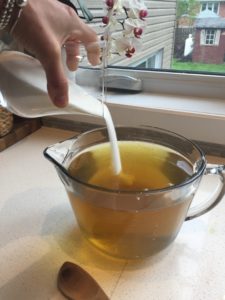
When the tea has been well infused and the mixture is still hot, add your sugar and mix well with a wooden spoon. Or you can simply do 2 differents bowls, one for sugar, one for tea and your mix everything together at the end.
The sugar will serve as food for the bacteria and yeasts that make up your Scoby.
Don’t worry, when the kombucha is ready, there should be very little sugar left. In fact, most of the sugar will be converted by the bacteria into acetic acid and carbon dioxide. Hence the sparkling effect of your kombucha …
Then add your sweet tea mixture to your previous kombucha base, the one that you kept since your last fermentation. If you don’t have a kombucha base to start the fermentation process, you can use 2 tablespoons of vinegar instead. You only use vinegar if you don’t have kombucha to start your new fermentation.
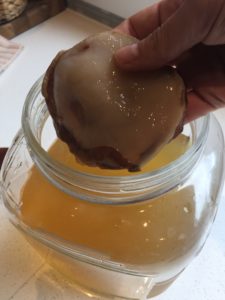
Make sure that the temperature of your mix is at room temperature before adding your scoby culture.
The scoby is actually a colony of live microorganisms/bacteria and if the mixture is too hot, it could be damaged.
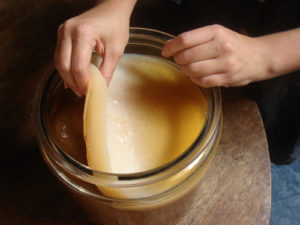
The scoby will either float or sink at the bottom. It doesn’t matter.
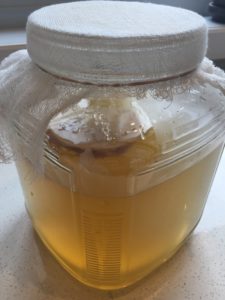
Cover the top of the jar with cheesecloth to prevent small fruit flies from getting in but allow air to enter.
Secure the fabric in place with an elastic band.
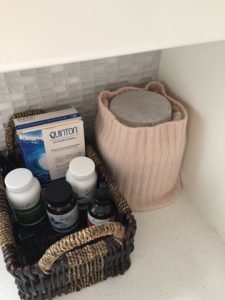
Leave to ferment 5 to 15 days, depending on the temperature. The sugar will momentarily change into alcohol during fermentation, then the alcohol will disappear as it is transformed into organic acids. When the beverage is ready, about 0.05% alcohol remains.
You should leave your mixture in an open area, in the shade or in a place with little light. The ideal room temperature should be between 23 and 30 degrees Celcius. Do not place in direct sunlight.
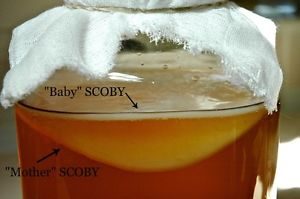
After 2-3 days, it is normal to see a membrane appear on the surface of your kombucha. This is a new Scoby forming.
Start tasting your kombucha from the 5th day. Taste it every day until you get the desired taste.
Kombucha should not taste to sweet or vinegary. If it tastes sweet, let it ferment a little more and test it twice a day until you get the desired taste.
If the kombucha tastes vinegary, it means that you have let the mixture ferment a little too long. You will know that you need to stop the process earlier next time. However, a vinegared kombucha would have more medicinal properties…it seems. Add a little juice if you don’t like the vinegar taste to balance the flavours.
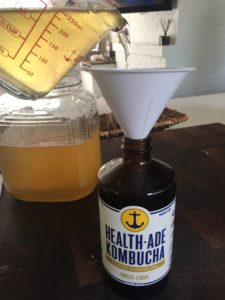
I transfer my Kombucha mixture into glass bottles. I really like to reuse old kombucha bottles that I bought in the past, but any glass bottle will do.
Don’t forget to save some kombucha so you can start your next batch.
Aromatiser vos boissons de kombucha à votre goût
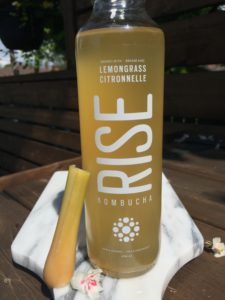
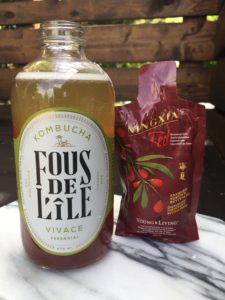
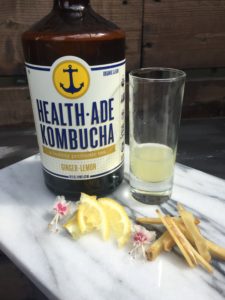
I flavour it also. Sometimes, I take inspiration from the recipe already written on the bottle or I improvise.
To flavour, be creative. You can add lemongrass sticks, pieces of ginger, lemon, zest, spearmint, chlorophyll, hibiscus flowers, nasturtium flowers, Ceylon cinnamon sticks, cardamom, etc… Sometimes I simply add a tbsp of my favorite NingxiaRed juice made from Wolfberry puree. PS: You don’t have to put in a lot.
One of my favorite way is to use essential oil to flavor my kombucha batch. I add 1 drop or 2 of my choice of vitality or plus oil. Try ginger, lemongrass, lemon, mint, black pepper, lavender, just be creative.
You can start drinking your kombucha right away, but I prefer to make a second fermentation. I like it when it’s very bubbly!
The champagne method
I use the champagne method because I love it when there are lots of bubbles in my kombucha. Sometimes there are even too many… it’s literally a fountain when I open my bottle. You’d think you were at the Formula One awards ceremony. lol!

In order to obtain a champagne effect, it is important to add some new sugar to our beverage and especially to continue the fermentation period. I get my sugar from fresh, dried or frozen fruit. You can very well use your flavoured kombucha and add 1 or 2 grapes (cut in half).
I fill the bottles very close to the rim, but I leave a little space for the sparkling effect to occur and I close tightly.
Then, I simply place the bottles in a dark place, at room temperature for another 4 to 7 days. Fermentation will continue and create even more carbon dioxide. Your Kombucha will then be super Sparkly! Be careful, it can really make a mess in the kitchen. Open carefully.
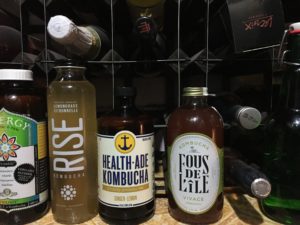
Now it’s time to enjoy your kombucha or put it in the fridge for storage.
You can start a new batch of kombucha immediately when your mix is ready or you can store your scoby in the fridge for about 1-2 month. Simply soak the culture in kombucha, place it in a glass jar and leave it open to allow air to penetrate.
Before I go, I strongly suggest that you start drinking kombucha gradually, especially if you have never drink it before. Take about 1 to 2 ounces per day to start and eventually, you can take it 3 times a day. Ideally, kombucha should be taken in the morning on an empty stomach and then after each meal.
If your body reacts to your kombucha, stop using it for a few days and start again with small doses.
It is wise to take temporary breaks from kombucha from time to time and not drink it 3 times a day 365 days a year.
I hope you liked this post. Try to make your own recipe and please let me know how it went.
À votre Santé! Cheers! Saluti! Skål! Prost! Ура! Salud!
Isabelle – Votre Amie Essentielle
If you like what you see here, make sure to follow me on instagram and facebook. I post regularly.
References:
Book Kombucha Tea for your Healyth and Healing. Par Alick & Mari Bartholomew.
Changes in content of organic acids and tea polyphenols during kombucha tea fermentation
Article sur l’effet inhibiteur du thé sur l’absorption du fer par le corps

